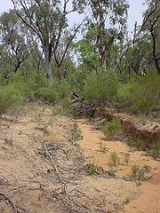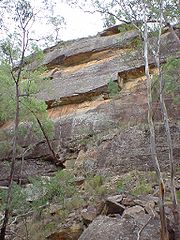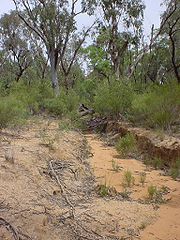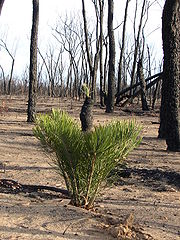
Pilliga forest
Encyclopedia



Pilliga, New South Wales
Pilliga is a village 105 km west of Narrabri in the North West Plains section of the New England region of New South Wales, Australia. The village is within Narrabri Shire Local Government Area....
), constitute some 3000 km2 of semi-arid woodland in temperate north-central New South Wales
New South Wales
New South Wales is a state of :Australia, located in the east of the country. It is bordered by Queensland, Victoria and South Australia to the north, south and west respectively. To the east, the state is bordered by the Tasman Sea, which forms part of the Pacific Ocean. New South Wales...
, Australia
Australia
Australia , officially the Commonwealth of Australia, is a country in the Southern Hemisphere comprising the mainland of the Australian continent, the island of Tasmania, and numerous smaller islands in the Indian and Pacific Oceans. It is the world's sixth-largest country by total area...
. It is the largest such continuous remnant in the state.
History
Author Eric Rolls wrote a seminal work on the Pilliga called A Million Wild AcresA Million Wild Acres
A Million Wild Acres: 200 years of man and an Australian forest' is a non-fiction book written by Eric Charles Rolls . It was first published in Melbourne by Nelson in 1981...
, which gives an insight into the history of the region. One of Rolls' most-cited conclusions is that the forest used to be an open woodland forest and that European influence has enabled the cypress pine to dominate. However, many scientific authors now disagree with much of Rolls' analysis, quoting historical records from as early as the 1870s which suggest that the plant communities in the scrub have not undergone the level of alteration that Rolls suggests. However most of his history of the region is uncontested and his book remains an invaluable document for understanding the region.
Geology
The geology of the area is dominated by Pilliga sandstone, a coarse red to yellow JurassicJurassic
The Jurassic is a geologic period and system that extends from about Mya to Mya, that is, from the end of the Triassic to the beginning of the Cretaceous. The Jurassic constitutes the middle period of the Mesozoic era, also known as the age of reptiles. The start of the period is marked by...
sandstone
Sandstone
Sandstone is a sedimentary rock composed mainly of sand-sized minerals or rock grains.Most sandstone is composed of quartz and/or feldspar because these are the most common minerals in the Earth's crust. Like sand, sandstone may be any colour, but the most common colours are tan, brown, yellow,...
containing about 75% quartz
Quartz
Quartz is the second-most-abundant mineral in the Earth's continental crust, after feldspar. It is made up of a continuous framework of SiO4 silicon–oxygen tetrahedra, with each oxygen being shared between two tetrahedra, giving an overall formula SiO2. There are many different varieties of quartz,...
, 15% plagioclase
Plagioclase
Plagioclase is an important series of tectosilicate minerals within the feldspar family. Rather than referring to a particular mineral with a specific chemical composition, plagioclase is a solid solution series, more properly known as the plagioclase feldspar series...
and 10% iron oxide
Iron oxide
Iron oxides are chemical compounds composed of iron and oxygen. All together, there are sixteen known iron oxides and oxyhydroxides.Iron oxides and oxide-hydroxides are widespread in nature, play an important role in many geological and biological processes, and are widely utilized by humans, e.g.,...
, although local variations in soil type do occur. Sandstone outcrops with basalt
Basalt
Basalt is a common extrusive volcanic rock. It is usually grey to black and fine-grained due to rapid cooling of lava at the surface of a planet. It may be porphyritic containing larger crystals in a fine matrix, or vesicular, or frothy scoria. Unweathered basalt is black or grey...
-capped ridges are common in the south, while the Pilliga outwash areas in the north and west are dominated by alluvium
Alluvium
Alluvium is loose, unconsolidated soil or sediments, eroded, deposited, and reshaped by water in some form in a non-marine setting. Alluvium is typically made up of a variety of materials, including fine particles of silt and clay and larger particles of sand and gravel...
from flooding creeks. Gilgai
Gilgai
Gilgai is an Australian English word referring to a small, ephemeral lake formed from a depression in the soil surface. Gilgais are commonly a few metres across and less than 30 cm deep, however in some instances they may be several metres deep and up to 100 metres across. Gilgais are common...
s occur in some areas. In the west "sand monkeys" (abandoned creek beds) are common. In the east is a heavily eroded sandstone mountain range, visible in outcrops such as those around Gin's Leap between Baan Baa and Boggabri.
Flora and fauna
The forest contains at least 900 plant species, including some now widely grown in cultivation as well as many threatened species. Some areas of the forest, particularly in the western Pilliga, are dominated by cypress-pineCallitris
Callitris is a genus of coniferous trees in the Cupressaceae . There are 15 species in the genus, of which 13 are native to Australia and the other two native to New Caledonia. Traditionally the most widely used common name is cypress-pine, a name shared by the closely related genus Actinostrobus...
(Callitris
Callitris
Callitris is a genus of coniferous trees in the Cupressaceae . There are 15 species in the genus, of which 13 are native to Australia and the other two native to New Caledonia. Traditionally the most widely used common name is cypress-pine, a name shared by the closely related genus Actinostrobus...
spp.). However there are a variety of distinct plant communities in the forest, some of which do not include Callitris. Another prominent sub-canopy genus are the she-oaks
Casuarinaceae
Casuarinaceae is a family of dicotyledonous flowering plants placed in the order Fagales, consisting of 3 or 4 genera and approximately 70 species of trees and shrubs native to the Old World tropics , Australia, and the Pacific Islands...
, while eucalypt
Eucalypt
Eucalypts are woody plants belonging to three closely related genera:Eucalyptus, Corymbia and Angophora.In 1995 new evidence, largely genetic, indicated that some prominent Eucalyptus species were actually more closely related to Angophora than to the other eucalypts; they were split off into the...
s dominate the canopy throughout the forest.
Fauna recorded from the Pilliga Nature Reserve include at least 36 native and nine introduced mammals, 50 reptiles and at least 15 frogs. Squirrel Glider
Squirrel Glider
The Squirrel Glider is a nocturnal gliding possum, one of the wrist-winged gliders of the genus Petaurus.-Habitat:...
s, Koala
Koala
The koala is an arboreal herbivorous marsupial native to Australia, and the only extant representative of the family Phascolarctidae....
s, Rufous Bettongs and Pilliga Mice
Pilliga Mouse
The Pilliga Mouse is a species of rodent in the family Muridae.It is found only in the Pilliga forest region of New South Wales, Australia.-References:* Baillie, J. 1996. . Downloaded on 19 July 2007....
are present..
Birds
A 4909 km2 tract of land, including the forest and the nearby Warrumbungle National ParkWarrumbungle National Park
Warrumbungle National Park is located in central northern New South Wales, Australia, 550 km northwest of Sydney. Outside of the Sydney metropolitan area parks, it is the most-visited national park in New South Wales....
, has been identified by BirdLife International
BirdLife International
BirdLife International is a global Partnership of conservation organisations that strives to conserve birds, their habitats and global biodiversity, working with people towards sustainability in the use of natural resources...
as an Important Bird Area
Important Bird Area
An Important Bird Area is an area recognized as being globally important habitat for the conservation of bird populations. Currently there are about 10,000 IBAs worldwide. The program was developed and sites are identified by BirdLife International...
(IBA) because it supports populations of Painted Honeyeater
Painted Honeyeater
The Painted Honeyeater is a species of bird in the Meliphagidae family. It is monotypic within the genus Grantiella.It is endemic to Australia. Its natural habitat is subtropical or tropical dry forests...
s and Diamond Firetail
Diamond Firetail
The Diamond Firetail Stagonopleura guttata is a species of estrildid finch found in eastern Australia, from Eyre Peninsula, South Australia, to south-eastern Queensland, commonly found on the slopes of the Great Dividing Range. The bird lives in eucalypt forest and woodland, mallee country,...
s. It also experiences irregular occurrences of endangered Swift Parrot
Swift Parrot
The Swift Parrot breeds in Tasmania and migrates north to south eastern Australia from Griffith-Warialda in New South Wales and west to Adelaide in the winter. It is related to the rosellas, with the feeding habits of a lorikeet...
s and Regent Honeyeater
Regent Honeyeater
The Regent Honeyeater, Xanthomyza phrygia, is an endangered bird endemic to Australia. It feeds on nectar and insects within eucalyptus forests. Recent genetic research suggests it is closely related to the wattlebirds.-Distribution:...
s, and near threatened
Near Threatened
Near Threatened is a conservation status assigned to species or lower taxa that may be considered threatened with extinction in the near future, although it does not currently qualify for the threatened status...
Bush Stone-curlew
Bush Stone-curlew
The Bush Stone-curlew or Bush Thick-knee is a large, ground-dwelling bird endemic to Australia...
s. Other declining woodland birds present in good numbers include Barking Owl
Barking Owl
The Barking Owl , also known as the Barking Boobook or Winking Owl, is a nocturnal bird species native to mainland Australia and parts of Papua New Guinea. They are a medium-sized brown owl and have an extremely characteristic voice that can range from a barking dog noise to a shrill woman-like...
s, Glossy Black-Cockatoo
Glossy Black-Cockatoo
The Glossy Black Cockatoo , also known as the Casuarina Black Cockatoo after one of their preferred food items, is the smallest member of the subfamily Calyptorhynchinae found in Australia. Adult Glossy Black Cockatoos may reach 50 cm in length. They are sexually dimorphic...
s, Grey-crowned Babbler
Grey-crowned Babbler
The Grey-crowned Babbler is a species of bird in the Pomatostomidae family.It is found in Australia, Indonesia, and Papua New Guinea....
s, Speckled Warbler
Speckled Warbler
The Speckled Warbler is a species of bird in the family Acanthizidae, where it belongs to the monotypic genus Chthonicola. It is endemic to Australia...
s, Brown Treecreeper
Brown Treecreeper
The Brown Treecreeper is the largest Australasian treecreeper. The bird is endemic to eastern Australia, found in eucalypt forests and woodlands of the Great Dividing Range. The Brown Treecreeper is pale brown to grey-brown, with black streaking on the underparts and black bars on the undertail....
s, Hooded Robin
Hooded Robin
The Hooded Robin is a small passerine bird native to Australia. Like many brightly coloured robins of the Petroicidae it is sexually dimorphic; the male bearing distinctive black and white coloured plumage, while the female is a nondescript grey-brown.-Taxonomy:Like all Australian Robins, it is...
s and Turquoise Parrot
Turquoise Parrot
The Turquoise Parrot is a parrot previously widespread in Eastern Australia, though now mainly found in northeastern New South Wales and north-eastern Victoria....
s.
Fires
Fire plays a major role in the ecology of the forest with many plant species depending on fire to regenerate. However in unfavorable conditions fire can be extremely intense, spread very quickly and threaten nearby properties as well as laying waste to entire ecosystems. If intense fires occur less than 15 years apart there can be a loss of plant and animal biodiversity. The magnitude of historical Pilliga bushfires correlates extremely well with the El Nino Southern Oscillation phenomena, with El Nino (dry) years having the most severe fires.In 1997 a major fire burned close to 1,435 km² of the forest. An extremely dry winter and spring in 2006 saw a number of large fires develop, including the Pilliga 4 Fire in November/December which burned out 740 km² on just its first day.
Access and attractions
Towns in the area include NarrabriNarrabri, New South Wales
Narrabri is a town and seat of Narrabri Shire Council Local Government Area in the North West Slopes, New South Wales, Australia. Narrabri is situated on the Namoi River and lies northwest of Sydney. It sits on the junction of the Kamilaroi Highway and the Newell Highway...
, Pilliga, Gwabegar
Gwabegar, New South Wales
Gwabegar, New South Wales, Australia, is a village located in the middle of the largest naturally forming cypress pine forest in the Southern Hemisphere, the Pilliga State Forest...
, Baradine
Baradine, New South Wales
Baradine is a small town in northern New South Wales, Australia. At the 2006 census, Baradine had a population of 593.Baradine is located on the Coonabarabran-Pilliga road, about midway between Coonabarabran and Pilliga...
, Coonabarabran
Coonabarabran, New South Wales
Coonabarabran is a town in Warrumbungle Shire in northern New South Wales, Australia. At the 2006 census, the town had a population of 2,609.-History and description:...
, Boggabri
Boggabri, New South Wales
Boggabri is a small town on the Kamilaroi Highway in north-western New South Wales, Australia in Narrabri Shire, between Gunnedah and Narrabri. In 2006, the town had a population of 901 people....
and Baan Baa
Baan Baa, New South Wales
Baan Baa, pronounced "barn-bar", is a village located in northern inland New South Wales, Australia in Narrabri Shire Local Government Area and Pottinger County. It is approximately 38 kilometres south-east of Narrabri and 58 km north-west of Gunnedah on the Kamilaroi Highway...
. There is an extensive network of roads throughout the scrub, many of which are former forestry roads. The forest once supported a large forestry industry in the surrounding towns (harvesting mostly cypress pine and ironbarks) however this has been greatly scaled back since 2005 when much of the forest was set aside for environmental conservation by the NSW government.
There are many attractions in the forest, including:
- Salt caves: shallow sandstone caves in the middle of the Pilliga
- Dandry Creek Gorge: sandstone cliff toward the south of the Pilliga
- Pilliga Pottery: off the highway north of Coonabarabran
- Bird-watching: many species of birds occur in the forest; the Baradine Visitor's Centre has information leaflets

